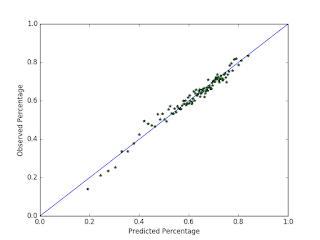An Interesting Game
Today I'm going to talk about an interesting game that I thought of, and in particular I'll show the probability that each player will win. While the rules of the game are not fair, the skill levels of each player are not necessarily the same either, so I formally define what I mean and find the conditions under which these factors balance out. Without further ado, here is the problem statement: Alice and Bob play a game consisting of an indeterminate number of rounds. In each round, Alice and Bob compete to win the round, and thus score a point. Alice is more skilled at this game and so she wins each round with probability $ p > 0.5 $ (independent of the score and other context), meaning Bob wins each round with probability $ 1 - p $. The score starts at $ 0 - 0 $ and Bob wins if he ever has more points than Alice, and Alice wins otherwise. What is the probability that Bob wins this game? For what value of $ p $ is this game fair? W...


